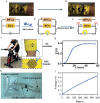Smart Electronic Textile-Based Wearable Supercapacitors
- PMID: 36192164
- PMCID: PMC9631069
- DOI: 10.1002/advs.202203856
Smart Electronic Textile-Based Wearable Supercapacitors
Abstract
Electronic textiles (e-textiles) have drawn significant attention from the scientific and engineering community as lightweight and comfortable next-generation wearable devices due to their ability to interface with the human body, and continuously monitor, collect, and communicate various physiological parameters. However, one of the major challenges for the commercialization and further growth of e-textiles is the lack of compatible power supply units. Thin and flexible supercapacitors (SCs), among various energy storage systems, are gaining consideration due to their salient features including excellent lifetime, lightweight, and high-power density. Textile-based SCs are thus an exciting energy storage solution to power smart gadgets integrated into clothing. Here, materials, fabrications, and characterization strategies for textile-based SCs are reviewed. The recent progress of textile-based SCs is then summarized in terms of their electrochemical performances, followed by the discussion on key parameters for their wearable electronics applications, including washability, flexibility, and scalability. Finally, the perspectives on their research and technological prospects to facilitate an essential step towards moving from laboratory-based flexible and wearable SCs to industrial-scale mass production are presented.
Keywords: electronic textiles; energy storage devices; smart textiles; supercapacitors; wearable electronics.
© 2022 The Authors. Advanced Science published by Wiley-VCH GmbH.
Conflict of interest statement
The authors declare no conflict of interest.
Figures




















References
-
- Peng H., Sun X., Cai F., Chen X., Zhu Y., Liao G., Chen D., Li Q., Lu Y., Zhu Y., Jia Q., Nat. Nanotechnol. 2009, 4, 738. - PubMed
-
- Shi X., Zuo Y., Zhai P., Shen J., Yang Y., Gao Z., Liao M., Wu J., Wang J., Xu X., Tong Q., Zhang B., Wang B., Sun X., Zhang L., Pei Q., Jin D., Chen P., Peng H., Nature 2021, 591, 240. - PubMed
-
- Wang L., Xie S., Wang Z., Liu F., Yang Y., Tang C., Wu X., Liu P., Li Y., Saiyin H., Zheng S., Sun X., Xu F., Yu H., Peng H., Nat. Biomed. Eng. 2020, 4, 159. - PubMed
Publication types
MeSH terms
Grants and funding
LinkOut - more resources
Full Text Sources
